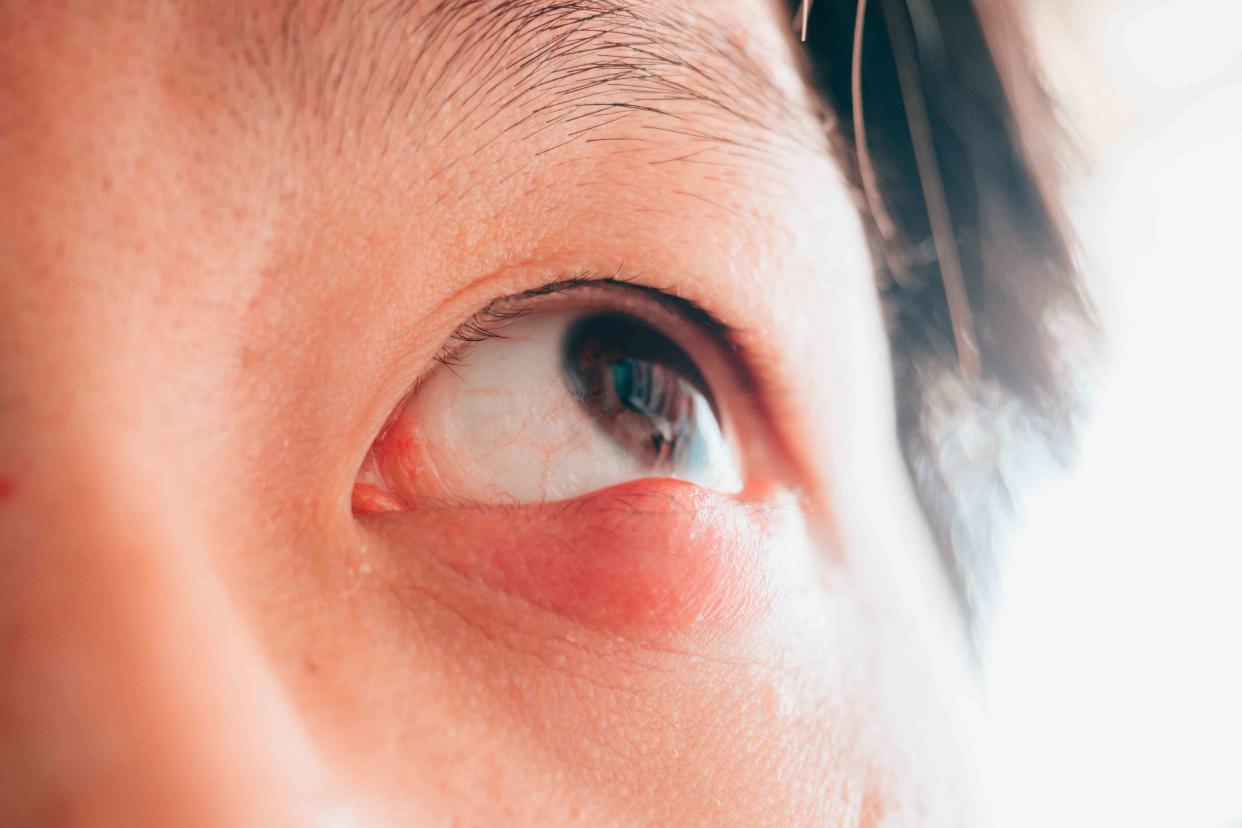What Is a Stye?

PansLaos / Getty Images
Medically reviewed by Bryan M. Wolynski, OD
A stye is a red bump that forms on the edges of your eyelid. The bump, which may look like a pimple, is an inflamed hair follicle or oil gland that may be painful to the touch. A stye is medically known as a hordeolum.
Styes are a very common eye condition that affect people of all ages. While the exact number of people impacted by styes each year is unknown, people between the ages of 30 and 50 tend to get them slightly more often than other people.
What Causes a Stye?
Styes are the result of a bacterial infection. When a hair follicle of an eyelash or an oil gland in your eyelid is blocked, the oil or sweat your glands make can't leave. Bacteria can then grow within the blocked follicle or gland.
When it's a hair follicle that is infected, the stye is known as an external hordeolum and appears at the base of your eyelash. When it's an oil gland that is infected, the stye is known as an internal hordeolum and develops inside your eyelid.
A stye usually develops over the course of a few days.
Risk Factors
Anyone can develop a stye, but you may be at greater risk if you:
Keep glands blocked by not removing make-up
Don't wash your hands before putting in or removing your contact lenses
Have blepharitis, a condition that causes your eyelids to be inflamed, itchy, and red
Have diabetes
Have seborrhoeic dermatitis, an inflammatory skin condition
Your stye might be worse if you have a common type of mites known as Demodex on your skin.
Stye Symptoms
The key characteristic of a stye is a painful red bump along the edge of your eyelid that may make your entire eyelid swell. Usually there is a small spot of pus at the center of the bump that makes the stye look like a pimple. Other symptoms of a stye may include:
Experiencing discharge from your eye
Having a scratchy feeling in your eye
Getting crust on your eyelid
Being sensitive to light
Feeling like something is in your eye
Related: 6 Eye Symptoms and What They Could Mean
How Is a Stye Diagnosed?
There are no diagnostic tests to determine whether you have a stye. Typically, a healthcare provider will diagnose your condition based on your medical history, your symptoms, and a physical evaluation.
A stye may look similar to a chalazion, which is a bump on the eyelid that grows slowly and isn't painful. While telling them apart can be difficult, the treatment is the same anyway.
How Do You Treat a Stye?
Normally, styes can be treated at home and will go away in about a week. To treat a stye at home, you can apply a warm, damp washcloth on your eye four times a day for 10 minutes each.
You should also:
Keep the area clean
Avoid touching or rubbing the stye
Avoid wearing make-up or contact lenses until the stye is gone
Not squeeze the stye and instead let it drain on its own
To help manage any pain, you can consider taking Advil (ibuprofen) or Tylenol (acetaminophen).
A healthcare provider may also prescribe an erythromycin ophthalmic ointment like Romycin Ophthalmic. The medication is put on the stye to kill the bacteria.
A healthcare provider may also drain the stye by making an opening in it.
Related: Eye Problems: Causes, Symptoms, and Treatments
How to Prevent Styes
The best way to prevent styes is to practice daily eyelid hygiene. Using a mild cleanser (like a baby shampoo) and warm water to gently wash along your eyelids can help keep the area clean. You also should be diligent about removing any eye and face make-up before going to sleep. If you need to touch the skin around your eyes or put in and take out contact lenses, wash your hands thoroughly before doing so.
Taking fish oil may also help prevent your oil glands from getting clogged. And if your styes are linked to having Demodex, you can treat that underlying condition, potentially with tea tree oil.
When to See a Healthcare Provider
While styes usually resolve with treatment at home like warm compresses and eyelid scrubs, there are times when you may need to see a healthcare provider like an optometrist or ophthalmologist (an eye care specialist). For instance, if the bump on your eyelid does not go away in a week or two, you should see a provider.
You should also make an appointment with a healthcare provider if:
The pain or swelling gets worse after a few days
Another stye develops
You develop a fever
You start having vision problems
Your eyelids have a lot of crusting or scaling
Your eye is red or the entire eyelid has turned red
You have excessive tears or are extremely sensitive to light
A blister forms on your eyelid
The stye bleeds
A Quick Review
A stye is a painful red bump that forms on your eyelid or under the eyelid when a hair follicle or oil gland becomes infected with bacteria. If you have a stye, you may experience tearing, crusting on your eyelid, and discharge from your eye. Usually, styes can be treated at home with warm compresses and proper hygiene and will resolve in about a week.
If your stye doesn't go away or continues to grow, becomes even more painful, or interferes with your daily activities, you should schedule an appointment with a healthcare provider. They can examine your eye, evaluate your symptoms, and make recommendations for treatment. You may need medication or a draining of your stye.
For more Health news, make sure to sign up for our newsletter!
Read the original article on Health.

